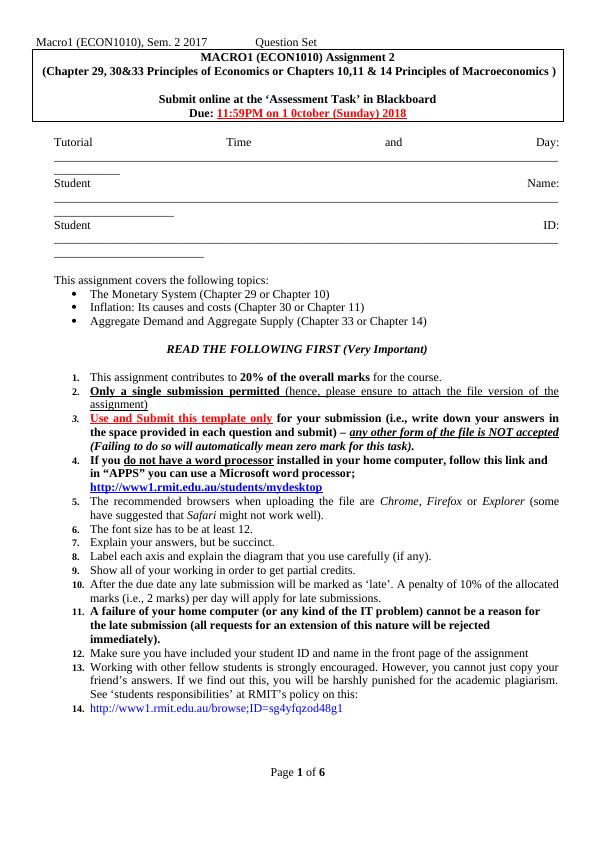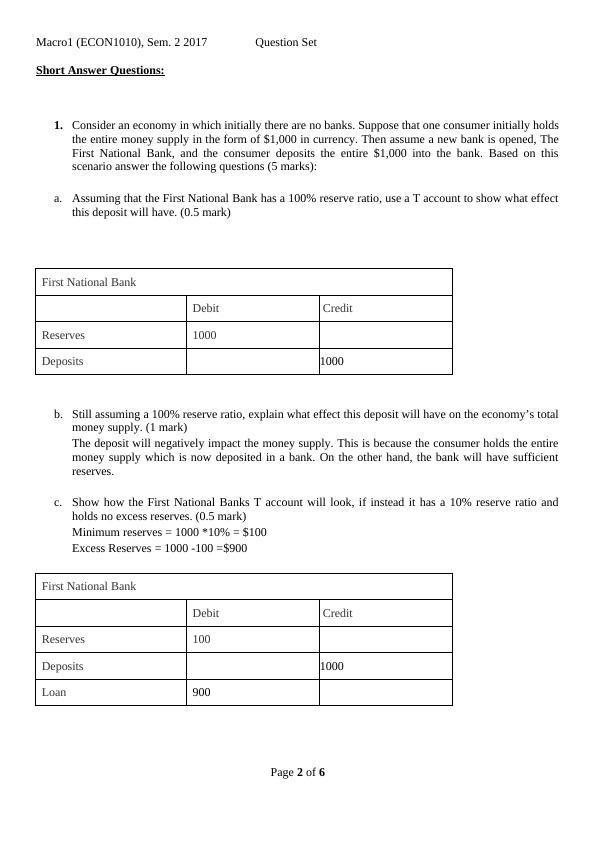Macroeconomics - Assignment Sample
6 Pages1807 Words212 Views
Added on 2020-03-15
Macroeconomics - Assignment Sample
Added on 2020-03-15
ShareRelated Documents
Macro1 (ECON1010), Sem. 2 2017 Question SetMACRO1(ECON1010) Assignment 2 (Chapter 29, 30&33 Principles of Economics or Chapters 10,11 & 14 Principles of Macroeconomics )Submit online at the ‘Assessment Task’ in Blackboard Due: 11:59PM on 1 0ctober (Sunday) 2018TutorialTimeandDay:_______________________________________________________________________________________________StudentName:________________________________________________________________________________________________________StudentID:_____________________________________________________________________________________________________________This assignment covers the following topics:The Monetary System (Chapter 29 or Chapter 10)Inflation: Its causes and costs (Chapter 30 or Chapter 11)Aggregate Demand and Aggregate Supply (Chapter 33 or Chapter 14)READ THE FOLLOWING FIRST (Very Important)1.This assignment contributes to 20% of the overall marks for the course. 2.Only a single submissionpermitted (hence, please ensure to attach the file version of theassignment)3.Use and Submit this template onlyfor your submission (i.e., write down your answers inthe space provided in each question and submit) – any other form of the file is NOT accepted(Failing to do so will automatically mean zero mark for this task).4.If you do not have a word processor installed in your home computer, follow this link and in “APPS” you can use a Microsoft word processor; http://www1.rmit.edu.au/students/mydesktop5.The recommended browsers when uploading the file are Chrome, Firefox or Explorer (somehave suggested that Safari might not work well).6.The font size has to be at least 12.7.Explain your answers, but be succinct. 8.Label each axis and explain the diagram that you use carefully (if any). 9.Show all of your working in order to get partial credits.10.After the due date any late submission will be marked as ‘late’. A penalty of 10% of the allocatedmarks (i.e., 2 marks) per day will apply for late submissions.11.A failure of your home computer (or any kind of the IT problem) cannot be a reason for the late submission (all requests for an extension of this nature will be rejected immediately). 12.Make sure you have included your student ID and name in the front page of the assignment13.Working with other fellow students is strongly encouraged. However, you cannot just copy yourfriend’s answers. If we find out this, you will be harshly punished for the academic plagiarism.See ‘students responsibilities’ at RMIT’s policy on this: 14.http://www1.rmit.edu.au/browse;ID=sg4yfqzod48g1Page 1 of 6

Macro1 (ECON1010), Sem. 2 2017 Question SetShort Answer Questions:1.Consider an economy in which initially there are no banks. Suppose that one consumer initially holdsthe entire money supply in the form of $1,000 in currency. Then assume a new bank is opened, TheFirst National Bank, and the consumer deposits the entire $1,000 into the bank. Based on thisscenario answer the following questions (5 marks):a.Assuming that the First National Bank has a 100% reserve ratio, use a T account to show what effectthis deposit will have. (0.5 mark)First National BankDebit CreditReserves 1000Deposits 1000b.Still assuming a 100% reserve ratio, explain what effect this deposit will have on the economy’s totalmoney supply. (1 mark)The deposit will negatively impact the money supply. This is because the consumer holds the entiremoney supply which is now deposited in a bank. On the other hand, the bank will have sufficientreserves.c.Show how the First National Banks T account will look, if instead it has a 10% reserve ratio andholds no excess reserves. (0.5 mark)Minimum reserves = 1000 *10% = $100Excess Reserves = 1000 -100 =$900First National BankDebit CreditReserves 100Deposits 1000Loan900Page 2 of 6

Macro1 (ECON1010), Sem. 2 2017 Question Setd.Following form c. if other banks now open up and face a 10% reserve ratio, and assuming that everyconsumer holds her or his money as deposits instead of currency, explain what effect the initialdeposit will eventually have on the money supply. (1 mark)In case other banks are able to open up and they get a 10% reserve ratio, they are therefore able togive out loans from the excess reserves to the public. This money will be brought into the cyclethrough lending and the banks will continue to have excess reserves. The result will be increase inthe money supply since the amount deposited is multiplied by a money multiplier. = 1000 * 10 = 10000= 10000 - 1000 = 9000Money supply increases by 9000.e.Are consumers as a group wealthier when the banking system chooses a 10% reserve ratio. Explainthe reasons for your answer. (2 marks)In a sense the consumers become wealthier with a 10% reserve ratio, this is because a large amount ofthe money is loaned out and is able to gain interest also, the borrowers are able to invest in businessesthat are able to gain a return which increases the wealth of the entire economy.2.Using the AD-AS framework consider the following scenario. The economy is operating at fullemployment when an unanticipated crisis hits the banking sector that results in a credit squeeze. (4marks)a.Explain in detail how this event in the financial system is likely to impact the real economy and whatwill be the implications for unemployment and inflation in the short term. In your answer be sure toalso address which components of the AD-AS model may be impacted by this scenario. Your answershould be around ½ page. (3 marks)In case of a credit squeeze, the money supply is limited by the banks. This may mean that there is anincrease in the interest rates that make loanable funds less accessible to the borrowers who might require themoney not only to spend but also invest. In the short term therefore the aggregate demand may decreasesince there is reduced capacity to purchase. Due to the decrease in aggregate demand, the economy realoutput decreases while the prices also decrease. The level of inflation decreases and the unemploymentlevels increase due to reduced investment levels.Page 3 of 6

End of preview
Want to access all the pages? Upload your documents or become a member.
Related Documents
The Monetary System (Chapter 29 or Chap 29) and Macro1 (ECON1010), Sem. 2 2017 Question Setlg...
|5
|2083
|249
ECON1010- Principles of Economicslg...
|6
|1884
|123
MACRO1 (ECON1010) Assignment - Deskliblg...
|6
|2709
|226
Macro1 (ECON1010) - Assignmentlg...
|7
|3019
|194
MACRO1 _________________________ Assignment: Monetary Systemlg...
|8
|1496
|188
Recruitment and Retention Strategies for Project Teamslg...
|12
|3637
|492
